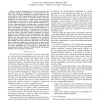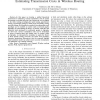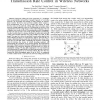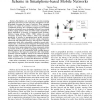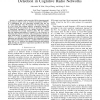INFOCOM
2010
IEEE
13 years 10 months ago
2010
IEEE
— In wireless networks, TCP performs unsatisfactorily since packet reordering and random losses may be falsely interpreted as congestive losses. This causes TCP to trigger fast r...
INFOCOM
2010
IEEE
13 years 10 months ago
2010
IEEE
—Network Tomography (or network monitoring) uses end-to-end path-level measurements to characterize the network, such as topology estimation and failure detection. This work prov...
INFOCOM
2010
IEEE
13 years 10 months ago
2010
IEEE
—In this paper we develop a unified theoretical framework for estimating various transmission costs of packet forwarding in wireless networks. Our framework can be applied to th...
INFOCOM
2010
IEEE
13 years 10 months ago
2010
IEEE
Abstract—Distributed storage systems provide large-scale reliable data storage by storing a certain degree of redundancy in a decentralized fashion on a group of storage nodes. T...
INFOCOM
2010
IEEE
13 years 10 months ago
2010
IEEE
Abstract—We consider multiuser scheduling in wireless networks with channel variations and flow-level dynamics. Recently, it has been shown that the MaxWeight algorithm, which i...
INFOCOM
2010
IEEE
13 years 10 months ago
2010
IEEE
—Despite much research on the throughput of relaying networks under idealized interference models, many practical wireless networks rely on physical-layer protocols that preclude...
INFOCOM
2010
IEEE
13 years 10 months ago
2010
IEEE
—Network coding has been proposed as a technique that can potentially increase the transport capacity of a wireless network via processing and mixing of data packets at intermedi...
INFOCOM
2010
IEEE
13 years 10 months ago
2010
IEEE
—Since the inception of network coding in information theory, we have witnessed a sharp increase of research interest in its applications in communications and networking, where ...
INFOCOM
2010
IEEE
13 years 10 months ago
2010
IEEE
INFOCOM
2010
IEEE
13 years 10 months ago
2010
IEEE
Abstract—In cognitive radio networks (CRNs), detecting smallscale primary devices—such as wireless microphones (WMs)— is a challenging, but very important, problem that has n...

